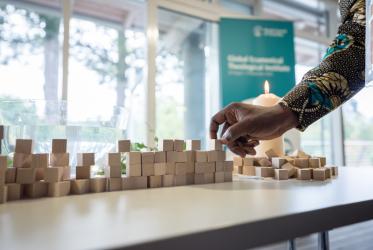by Friedrich Degenhardt (*)
Free photo of Usha Jesudasan available see below
How to teach religion in multifaith contexts is a growing concern for churches and religious communities everywhere. This interview presents a specific experience emerging from a multireligious context in Asia.
"Children from different religions can pray together in school," says Usha Jesudasan, a journalist and writer from India, where Christians, Hindus, Muslims and people of other religions live within the same local community. Jesudasan is committed to the concept of integrating interfaith religious and value education in schools to promote peace and harmony.
<span style="font-weight: bold; "» Do children need interfaith religious and value education in school?
Yes, they need both. First of all value education, because all around the world, India included, we live in situations where the home and the family is not THE place where values are transmitted any more. And we also live in a world where the values at home and the values at school are different.
Families are getting smaller. There are now families with only one parent, or with only one child. If you take the value of sharing for example, how do you teach a child from a one-child family what it means to share? It is very difficult. Similarly, how do you teach a child from a one-child family what it means to be compassionate?
In the past, you would have four brothers or three sisters and you would share coloured pencils, or one bar of chocolate. Today, when I buy sweets for my children, I buy one chocolate for each, and not one bar while saying "Please, share". So some values can only be taught at school.
Interfaith education is so important because children are fresh. They come with no prejudices. So it is easier to reach out to them, and then to teach them what is right and what is good.
<span style="font-weight: bold; "» Is religious education more meaningful when it comes from an authentic Christian perspective?
As a Christian mother, I try to teach my children that the way we worship is meaningful to us, but the way you worship is meaningful to you. We should not look down on the way you worship, because it is not our way.
But there are some things that we have in common. We both pray for example. I have my texts and scriptures, you have your texts and scriptures. When I touch my scriptures, I do it reverentially because they are important to me. When you touch your scriptures, you do it reverentially. Therefore I do not denigrate yours. That respect is something that we need to teach our children.
I do think we need this interfaith education in school. Twenty years ago, we all lived in different communities. This nearness we have now did not exist. Today, in India for example, our children are marrying people of different faiths. This is one more thing we have to handle.
My son has a Hindu girlfriend, and I need to come to an understanding of not just accepting her into my family, but accepting her faith into my family. We will sit at the same table and eat, but we say a grace before our meals, and she says her prayers. I have to integrate all of this.
<span style="font-weight: bold; "» And what about praying together?
We can do it in different ways. You say your prayer. I respect that, and I give you space to do it. And I say mine. Please give me the space to do it. That is one way of dealing with it.
The second way is learning to come to a point where I can pray for your needs in my tradition, and you can pray for my needs in your tradition, and I will be receptive. I am in pain, a piece of broken humanity, so please pray for me.
Children can pray together instantly when their friends are in trouble. They are not as hung up about it as we adults. They have a much better start because they don't come with our baggage. I have seen it in school when a child had a sick mother or a dying grandmother, or a child with a broken leg, or who has had an accident and gone blind. These are times when the teacher brings the group together, and yes, it works.
The teacher can say: please pray for this child's mother. Or, this child has broken her leg in school, and we will all pray. Yes, we need that! Children need to know that it doesn't matter whether you pray with beads, or whether you kneel down, or you hold your hands together. It's a sense of oneness that we need to teach our children.
[776 words]
(*) Friedrich Degenhardt is a journalist and a curate from the North Elbian Lutheran Church (Germany) currently seconded to the media relations office of the World Council of Churches in Geneva.
This feature is part of a series highlighting issues and experience of interreligious dialogue, and is published by the WCC in the context of the conference on a "critical moment in interreligious dialogue" hosted by the WCC, 7-9 June 2005, in Geneva.
Further information, news, documents and free high resolution photos are available on the conference website:





